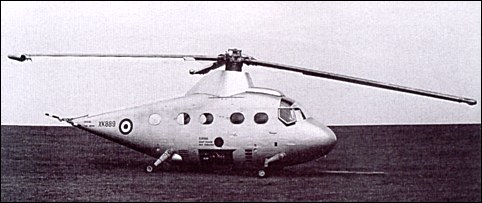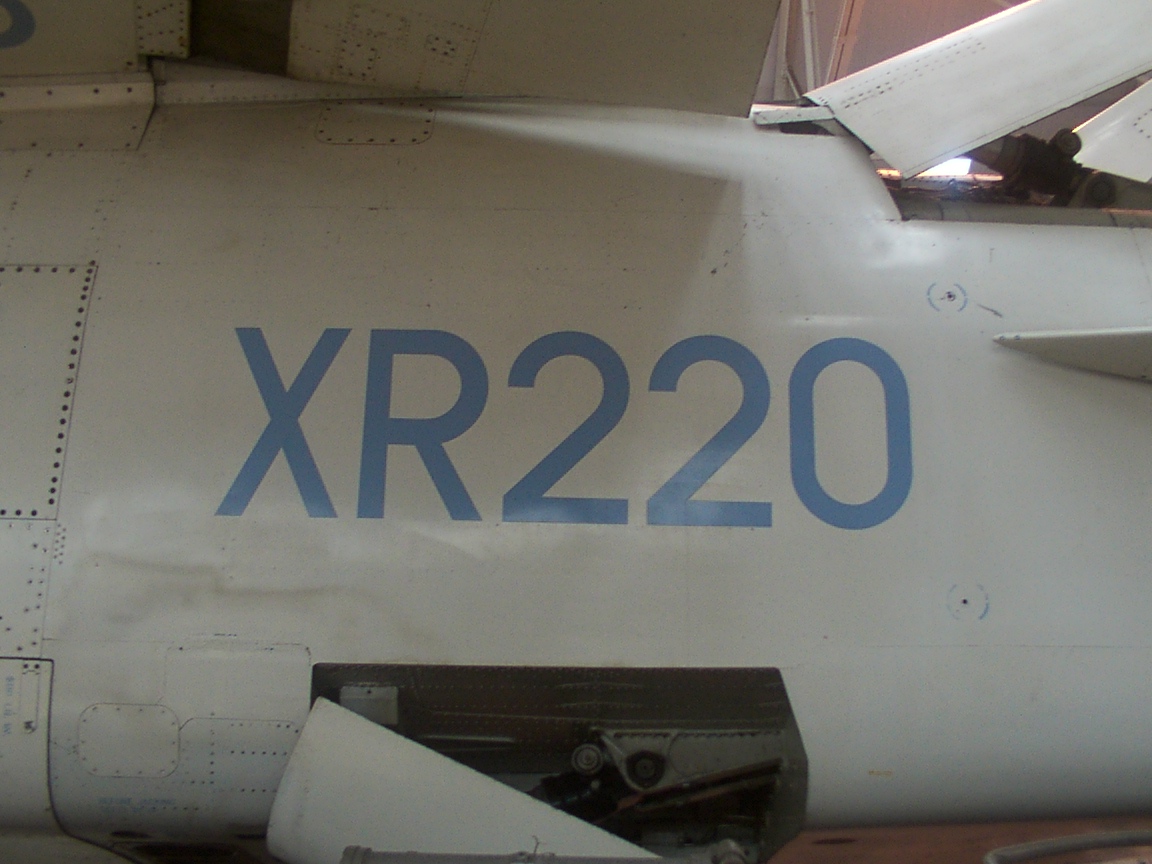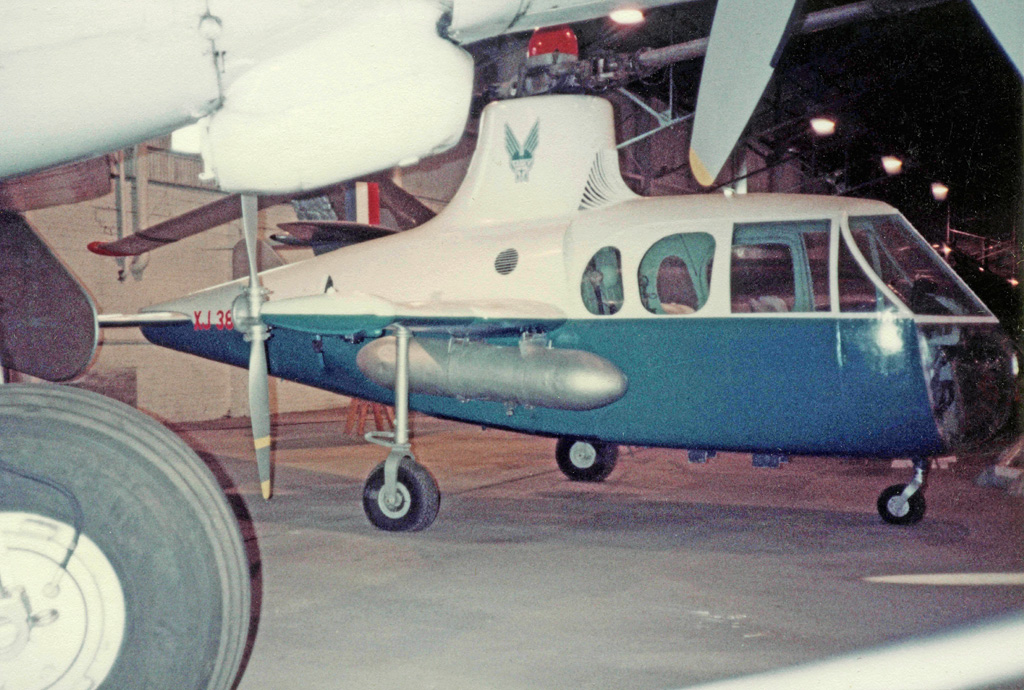|
Percival P.74
The Percival P.74 (later Hunting Percival P.74) was a British experimental helicopter designed in the 1950s that was based on the use of tip-jet powered rotors. Although innovative, the tip-rotor concept literally failed to get off the ground in the P.74, doomed by its inadequate power source. Rather than being modified, the P.74 was towed off the airfield and scrapped.Winchester 2005, p. 230. Design and development In 1951, Percival Aircraft Company formed a helicopter division, and began design work on a medium-sized helicopter designated P.74. They designed the helicopter to meet Air Ministry Specification EH.125D issued in May 1952 for an experimental helicopter to test jet driven rotors. This experimental helicopter had a teardrop-shaped fuselage with a two-seat cockpit in the nose and a large cabin that ran the full length of the fuselage. Beneath the cabin floor, two Napier Oryx gas generators fed compressed air to the tips of the three rotor blades through triple ej ... [...More Info...] [...Related Items...] OR: [Wikipedia] [Google] [Baidu] |
WikiProject Aircraft
A WikiProject, or Wikiproject, is a Wikimedia movement affinity group for contributors with shared goals. WikiProjects are prevalent within the largest wiki, Wikipedia, and exist to varying degrees within sister projects such as Wiktionary, Wikiquote, Wikidata, and Wikisource. They also exist in different languages, and translation of articles is a form of their collaboration. During the COVID-19 pandemic, CBS News noted the role of Wikipedia's WikiProject Medicine in maintaining the accuracy of articles related to the disease. Another WikiProject that has drawn attention is WikiProject Women Scientists, which was profiled by '' Smithsonian'' for its efforts to improve coverage of women scientists which the profile noted had "helped increase the number of female scientists on Wikipedia from around 1,600 to over 5,000". On Wikipedia Some Wikipedia WikiProjects are substantial enough to engage in cooperative activities with outside organizations relevant to the field at issue. Fo ... [...More Info...] [...Related Items...] OR: [Wikipedia] [Google] [Baidu] |
United Kingdom Military Aircraft Serials
United Kingdom military aircraft serial numbers are aircraft registration numbers used to identify individual military aircraft in the United Kingdom (UK). All UK military aircraft are allocated and display a unique registration number. A unified registration number system, maintained initially by the Air Ministry (AM), and its successor the Ministry of Defence (MoD), is used for aircraft operated by the Royal Air Force (RAF), Fleet Air Arm (FAA), and Army Air Corps (AAC). Military aircraft operated by government agencies and civilian contractors (for example QinetiQ) are also assigned registration numbers from this system. When the Royal Flying Corps (RFC) was formed in 1912, its aircraft were identified by a letter/number system related to the manufacturer. The prefix 'A' was allocated to balloons of No.1 Company, Air Battalion, Royal Engineers, the prefix 'B' to aeroplanes of No.2 Company, and the prefix 'F' to aeroplanes of the Central Flying School.Bruce 1956, p.922 ... [...More Info...] [...Related Items...] OR: [Wikipedia] [Google] [Baidu] |
Military Helicopters
A military helicopter is a helicopter that is either specifically built or converted for use by military forces. A military helicopter's mission is a function of its design or conversion. The most common use of military helicopters is transport of troops, but transport helicopters can be modified or converted to perform other missions such as combat search and rescue (CSAR), medical evacuation (MEDEVAC), airborne command post, or even armed with weapons for attacking ground targets. Specialized military helicopters are intended to conduct specific missions. Examples of specialized military helicopters are attack helicopters, observation helicopters and anti-submarine warfare helicopters. Types and roles Military helicopters play an integral part in the sea, land and air operations of modern militaries. Generally manufacturers will develop airframes in different weight/size classes which can be adapted to different roles through the installation of mission specific equipment. ... [...More Info...] [...Related Items...] OR: [Wikipedia] [Google] [Baidu] |
1950s British Experimental Aircraft
Year 195 ( CXCV) was a common year starting on Wednesday (link will display the full calendar) of the Julian calendar. At the time, it was known as the Year of the Consulship of Scrapula and Clemens (or, less frequently, year 948 ''Ab urbe condita''). The denomination 195 for this year has been used since the early medieval period, when the Anno Domini calendar era became the prevalent method in Europe for naming years. Events By place Roman Empire * Emperor Septimius Severus has the Roman Senate deify the previous emperor Commodus, in an attempt to gain favor with the family of Marcus Aurelius. * King Vologases V and other eastern princes support the claims of Pescennius Niger. The Roman province of Mesopotamia rises in revolt with Parthian support. Severus marches to Mesopotamia to battle the Parthians. * The Roman province of Syria is divided and the role of Antioch is diminished. The Romans annexed the Syrian cities of Edessa and Nisibis. Severus re-establish his hea ... [...More Info...] [...Related Items...] OR: [Wikipedia] [Google] [Baidu] |
Hunting Percival Aircraft
Hunting is the human practice of seeking, pursuing, capturing, or killing wildlife or feral animals. The most common reasons for humans to hunt are to harvest food (i.e. meat) and useful animal products ( fur/ hide, bone/ tusks, horn/antler, etc.), for recreation/ taxidermy (see trophy hunting), to remove predators dangerous to humans or domestic animals (e.g. wolf hunting), to eliminate pests and nuisance animals that damage crops/livestock/poultry or spread diseases (see varminting), for trade/tourism (see safari), or for ecological conservation against overpopulation and invasive species. Recreationally hunted species are generally referred to as the ''game'', and are usually mammals and birds. A person participating in a hunt is a hunter or (less commonly) huntsman; a natural area used for hunting is called a game reserve; an experienced hunter who helps organize a hunt and/or manage the game reserve is known as a gamekeeper. Many non-human animals also hun ... [...More Info...] [...Related Items...] OR: [Wikipedia] [Google] [Baidu] |
Fairey Rotodyne
The Fairey Rotodyne was a 1950s British compound gyroplane designed and built by Fairey Aviation and intended for commercial and military uses."Rotodyne, Fairey's Big Convertiplane Nears Completion: A Detailed Description." '''', 9 August 1957, Number 2533 Volume 72, pp. 191–197. A development of the earlier , which had established a world helicopter speed record, the Rotodyne featured a [...More Info...] [...Related Items...] OR: [Wikipedia] [Google] [Baidu] |
Hiller YH-32 Hornet
The Hiller YH-32 Hornet (company designation HJ-1) was an American ultralight helicopter built by Hiller Aircraft in the early 1950s. It was a small and unique design because it was powered by two Hiller 8RJ2B ramjet engines mounted on the rotor blade tips which weigh each and deliver an equivalent of for a total of . Versions of the HJ-1 Hornet were built for the United States Army and the United States Navy in the early 1950s. The Hiller Museum identifies the YH-32A, named the ''Sally Rand'', as the first helicopter gunship. Design and development The Hiller HJ-1 Hornet was an early attempt to build a jet-powered helicopter using ramjets. Before that there had been experiments with the XH-26 Jet Jeep tip rotor pulse jets. The HJ-1 ramjet tipped rotor propels the rotor and the aircraft. Unlike a conventional helicopter, this mechanically simple design avoids the need for a tail rotor. Unfortunately, the tip speeds on helicopter rotor blades are subsonic, and ramjets a ... [...More Info...] [...Related Items...] OR: [Wikipedia] [Google] [Baidu] |
Fiat 7002
The Fiat Model 7002 was a 1960s Italian general-purpose helicopter with a tip jet driven rotor built by Fiat Aviazione. Only one aircraft was built. Development In the early 1960s, under an Italian government contract, Fiat Aviazione designed the Model 7002, a medium-capacity transport helicopter. It had an unusually-shaped fuselage made from light-alloy sheets to provide accommodation for two crew and up to five passengers. The fuselage was mounted on a skid landing gear and the fuselage had a simple tailboom with a tail rotor. A two-blade main rotor was mounted above the fuselage, with the rotor driven by compressed air propulsion nozzles at the blade-tips. The compressed air was generated by a Fiat 4700 turbo gas generator located in the rear fuselage. The prototype A prototype is an early sample, model, or release of a product built to test a concept or process. It is a term used in a variety of contexts, including semantics, design, electronics, and software programmin ... [...More Info...] [...Related Items...] OR: [Wikipedia] [Google] [Baidu] |
Fairey Jet Gyrodyne
The Fairey Jet Gyrodyne is a British experimental compound gyroplane built by the Fairey Aviation Company that incorporated helicopter, gyrodyne and autogyro characteristics. The Jet Gyrodyne was the subject of a Ministry of Supply (MoS) research contract to gather data for the follow-up design, the Rotodyne. Design and development The Jet Gyrodyne was a modification of the second prototype FB-1 Gyrodyne aircraft registered ''G-AJJP''. The Jet Gyrodyne was built specifically to develop the pressure-jet rotor drive system and operational procedures used on the later Rotodyne. The Jet Gyrodyne utilised the fuselage, undercarriage and engine of the FB-1 Gyrodyne. The Alvis Leonides nine-cylinder radial engine was situated in the middle of the fuselage and drove a pusher propeller at the tip of each stub wing and two Rolls-Royce Merlin engine superchargers. The original three-blade tilting hub rotor system was replaced by a two-blade rotor controlled with swashplate-actuated c ... [...More Info...] [...Related Items...] OR: [Wikipedia] [Google] [Baidu] |
Napier NOr
Napier may refer to: People * Napier (surname), including a list of people with that name * Napier baronets, five baronetcies and lists of the title holders Given name * Napier Shaw (1854–1945), British meteorologist * Napier Waller (1893–1972), Australian muralist, mosaicist and painter Places Antarctica * Napier Island, in Marguerite Bay, on the Fallières Coast * Napier Mountains, in Enderby Land, East Antarctica * Napier Peak, in the South Shetland Islands, Western Antarctica * Napier Rock, in Admiralty Bay, King George Island, South Shetland Islands Australia * Mount Napier, a dormant volcano in Victoria * Napier Range, a mountain range in Western Australia * Napier County, New South Wales * Napier, New South Wales, a locality in the Riverina region * Electoral district of Napier, a former electoran district in South Australia Canada * Napier, Ontario, an unincorporated place in Middlesex County * Napier Bay, an Arctic waterway in Qikiqtaaluk Region, Nunavut Indi ... [...More Info...] [...Related Items...] OR: [Wikipedia] [Google] [Baidu] |
Rolls-Royce RB108
The Rolls-Royce RB.108 was a British jet engine designed in the mid-1950s by Rolls-Royce specifically for use as a VTOL lift engine. It was also used to provide horizontal thrust in the Short SC.1. Design and development The RB.108 was the first direct-lift turbojet produced by Rolls-Royce. It originated from a VTOL concept in which Alan A. Griffith proposed using a small number of specialised lift engines in a VTOL aircraft, separate from the engines which provided forward propulsion. Its power output (thrust) was not high enough for use as a practical engine in a production aircraft and was used only for research into VTOL. It was constructed from conventional materials. (The next engine, the RB.162, would have a compressor built mainly from glass-fibre composite and have a higher T/W ratio.) The RB.108 bearings and oil system were designed to operate with an engine attitude envelope which covered engine and aircraft tilting while transitioning between hovering and forw ... [...More Info...] [...Related Items...] OR: [Wikipedia] [Google] [Baidu] |
Percival P-74 2
Percival (, also spelled Perceval, Parzival), alternatively called Peredur (), was one of King Arthur's legendary Knights of the Round Table. First mentioned by the French author Chrétien de Troyes in the tale ''Perceval, the Story of the Grail'', he is best known for being the original hero in the quest for the Grail, before being replaced in later English and French literature by Galahad. Etymology and origin The earliest reference to Perceval is in Chrétien de Troyes's first Arthurian romance ''Erec et Enide'', where, as "Percevaus li Galois" (Percevaus of Wales), he appears in a list of Arthur's knights; in another of Chrétien's romances, '' Cligés'', he is a "renowned vassal" who is defeated by the knight Cligés in a tournament. He then becomes the protagonist in Chrétien's final romance, ''Perceval, the Story of the Grail''. In the Welsh romance ''Peredur son of Efrawg'', the figure goes by the name Peredur. The name "Peredur" may derive from Welsh ''par'' (spea ... [...More Info...] [...Related Items...] OR: [Wikipedia] [Google] [Baidu] |







